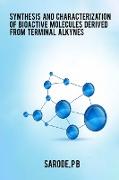- Start
- Synthesis and characterization of bioactive molecules derived from terminal alkynes
Synthesis and characterization of bioactive molecules derived from terminal alkynes
Angebote / Angebote:
Terminal alkyne: a versatile synthon for the synthesis of bioactive molecules 1.1 Introduction 1.1.1 History of alkynes Alkynes are one of the fundamental functiohal groups that established the foundation of organic chemistry.l The smallest member of this family, acetylene, was first discovered in 1836 by Edmund Davy.2 ln 1862, Friedrich Wohler discovered the generation of acetylene from the hydrolysis of calcium carbide (Scheme 1). GaC2 + H2O - H:H + Ca(OH)z l Scheme 1. Acetylene produced by this reaction was the main source of organic chemicals in the coal-based chemical industries. When petroleum was replaced by coal as the chief source of carbon in the 1950s, the partial combustion of methane became the prevalent industrial manufacture processes for acetylene (Scheme 2). 2CHa+Ql2lOz + H:H+3H2O Scheme 2. According to Ferdinand Bohlmann, the first naturally occurring acetylenic compound, dehydromatricaria ester I was isolated from an Artemisia species in 1826.3 Over a thousand naturally occurring acetylenes have been discovered and reported in lgth and 20th centuries.a Polyynes, a subset of this class of natural products, have been isolated from a wide variety of plant species, 4u-" cultures of higher fungi, s bacteria, marine sponges, and corals.6 In addition, dihydromatricaria acid 2 is the unique example of a polyyne obtained from an insect, the soldier beetle.T At present over 1000 compounds with two or more conjugated C=C bonds have been isolated.s These compounds represent a distinctive class of compounds with a significant array of biological activities, such as antibacterial, antimicrobial, antifungal, antitumor, anticancer, anti
Folgt in ca. 5 Arbeitstagen

